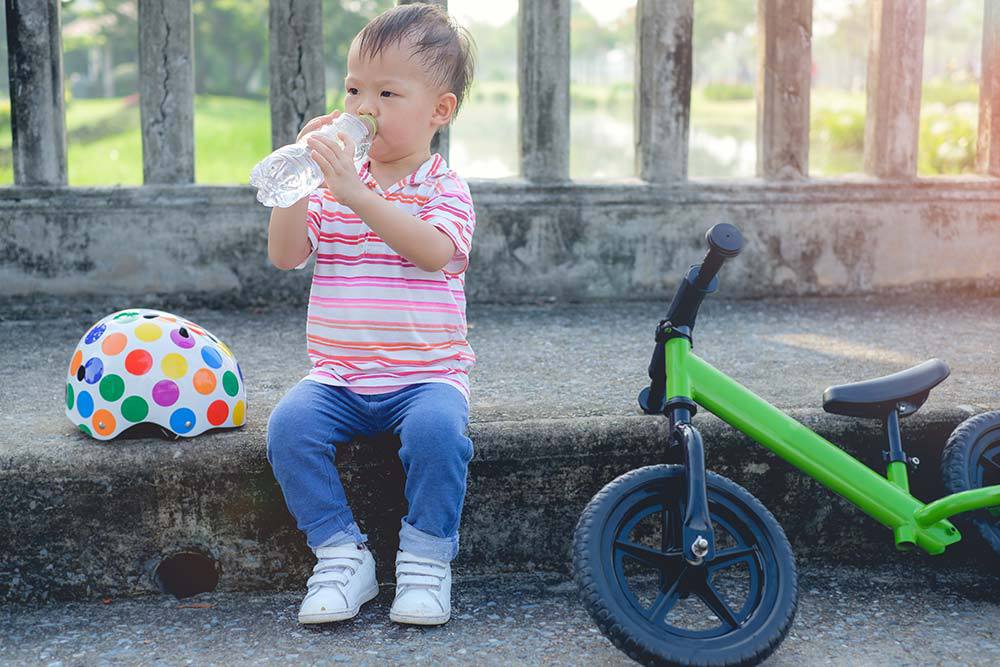The Dangers of Overheating in Babies and Kids

How to prevent, identify, and treat heat exhaustion and heat stroke.
Medical Expert: William Chu, MD
Recently, I was with my 4-year-old at an outdoor birthday party. It was sunny and well over 85 degrees Fahrenheit, and thanks to a bouncy house full of energetic kids, my daughter was a red-faced, sweaty mess. Despite my attempts to get her to drink her water, she began to look a little unwell as time passed. By the time we reached the 90-minute mark, she was curled up in my lap, pleading to leave– and they hadn’t even served cake yet! Within minutes of getting on the road, she vomited everywhere—and I knew in my gut that this wasn’t the result of a virus. She was showing signs of overheating.
After driving home with the air conditioning blasting, I carried her upstairs and filled the bathtub with cool water. As her body heat dropped to normal, and she was looking and acting more like herself, I gave her a popsicle for good measure (and to make her smile) and a fresh bottle of ice water to help her hydrate. By this point, I was so relieved she was feeling better, but I was also amazed by how quickly everything happened, especially since I had been actively taking steps to avoid it.
“Heat causes more injury and illness than any other weather condition,” says William Chu, MD, a board-certified pediatrician and medical director at Pediatrix Primary + Urgent Care of Texas. “Each year there are more than 60,000 emergency room visits and about 700 deaths due to heat-related illness.”
As the summer temps continue to rise and extreme heat becomes more prevalent, it’s important to know how to prevent, identify, and treat overheating in babies and kids.
What Is Overheating and What Are the Signs?
The word “overheating” is a broad, general term used to describe what happens when a person’s body temperature rises to the point that they experience physical symptoms of heat-related illness. According to the American Academy of Pediatrics (AAP), babies and children can experience heat cramps, heat exhaustion, and heatstroke (sometimes called sunstroke) as a result of overheating.
Overheating is typically the combined result of exposure to hot weather, exertion, and dehydration (both as a result of sweating and inadequate fluid intake). Dr. Chu says the first signs your child may overheat are typically sweating and thirst. From there, if the illness isn’t treated, he says symptoms will progress and may include headaches, dizziness, irritability, confusion, weakness, cramping, increased body temperature, dry skin, and dark or decreased urine.
Overheating becomes more severe the longer it goes untreated. Common signs and progression are as follows:
- Heat cramps: Intense, sometimes severe, cramping in the legs and stomach. A child may also experience tightness or spasms in the hands. They will not have a fever. Once treated, symptoms will go away within a few hours.
- Heat exhaustion: Profuse sweating, pale skin, nausea, dizziness, fainting, and/or weakness. Possible short-term mild fever—between 100 and 102 degrees Fahrenheit—though there is usually no fever. Severe symptoms, including fainting and weakness, should be urgently assessed by a doctor. Mild symptoms can be treated at home but should be evaluated by a doctor if they persist after a few hours.
- Heatstroke: Life-threatening and considered an emergency. Hot, flushed skin with a high fever of over 105 degrees Fahrenheit. Sweat may or may not be present (50% of children who have progressed to heatstroke do not sweat). It can cause confusion, coma, or shock.
“Heat stroke can cause permanent brain and organ damage or even death without immediate treatment,” cautions Dr. Chu. “Other heat-related illnesses include … syncope (fainting), muscle cramps and rhabdomyolysis (muscle breakdown and kidney damage), and heat rash.”
What Puts Babies and Kids at Risk of Overheating?
Babies and children are generally more susceptible to dehydration and heat illness simply because of their size and typical behaviors. According to the United States Environmental Protection Agency (EPA), children lose more fluid quicker than adults and have a smaller body mass-to-surface area ratio. Additionally, younger children don’t understand their body’s increased need for water and rest in hot weather. Finally, the EPA mentions babies left in car seats in unattended vehicles as a major contributing factor to heat-related deaths.
Dr. Chu notes that babies and children with chronic illnesses that cause them to lose fluids more quickly or who have disabilities that make them unable to ask for water or get it on their own are at an elevated risk of overheating. Also, “Children who are sick with fever, vomiting, or diarrhea can get dehydrated and overheat more quickly” than they might when they are healthy, and “certain medications and drinks with caffeine can also cause fluid loss and dehydration,” which can lead to overheating. He also mentions that children with a history of overheating are more likely to experience heat-related illness again.
As for external factors, the AAP says a heat index (which may not be the same as the temperature) at or above 90 degrees Fahrenheit puts kids at an elevated risk of overheating. Additionally, the risk of overheating is higher when it is not just hot but also humid. The AAP also reminds caregivers that it takes eight to 10 days to become used to summer temperatures, so the first heat wave carries an extra threat (this also applies to vacations).
How to Prevent Overheating
Thankfully, Dr. Chu says overheating in children is usually easily prevented with proper safeguards. He advises parents to take caution in temperatures as low as 80 degrees Fahrenheit (remember, temperature and heat index are not the same) and to take extreme caution once the temperature reaches 85 degrees or higher.
Some preventative measures include:
- Make sure your child drinks plenty of fluids (fluid-rich foods are good for snacks, too—such as watermelon or grapes).
- Encourage your child to take breaks from playing.
- Dress your child in light-colored, loose-fitting clothing (and don’t forget sunscreen!).
- Avoid strenuous activities during the hottest parts of the day (around 3 p.m.).
- Plan activities around the heat, such as swimming in a cold pool or staying inside in a cooler room with board games.
- Take breaks to cool down in air conditioning (if you don’t have AC at home, go to a public space if needed).
- Use a system or technology to help ensure you do not forget your infant in the backseat of your vehicle.
What to Do if Your Child Is Overheating
Sometimes, even with the best intentions, your child will still become overheated, but if you spot the signs and treat your child quickly, you can usually avoid an emergency. Dr. Chu stresses that heat-related illnesses progress, so you should act as soon as possible upon the onset of symptoms.
Some measures to take include:
- Get your child out of the heat to a cooler, drier space (indoors if possible, under shade, and out of direct sunlight if not).
- Have them drink fluids (water is best, but sports drinks with electrolytes or simple juices can also work in a pinch).
- Change them out of sweaty clothing and wipe them down with a cool, wet cloth.
- Run a cool bath.
- Have your child lie down (in a cool space) with their feet elevated.
- Do not try to treat the fever with medication (it won’t work in this case).
- Seek emergency care for severe symptoms; call the doctor for persistent mild symptoms.
The summer brings so much fun and joy, but your child is no match for extreme heat. Take steps to help your little one stay safe in the warm weather, and don’t forget to fill up an extra water bottle (or two) for yourself while you’re at it.








